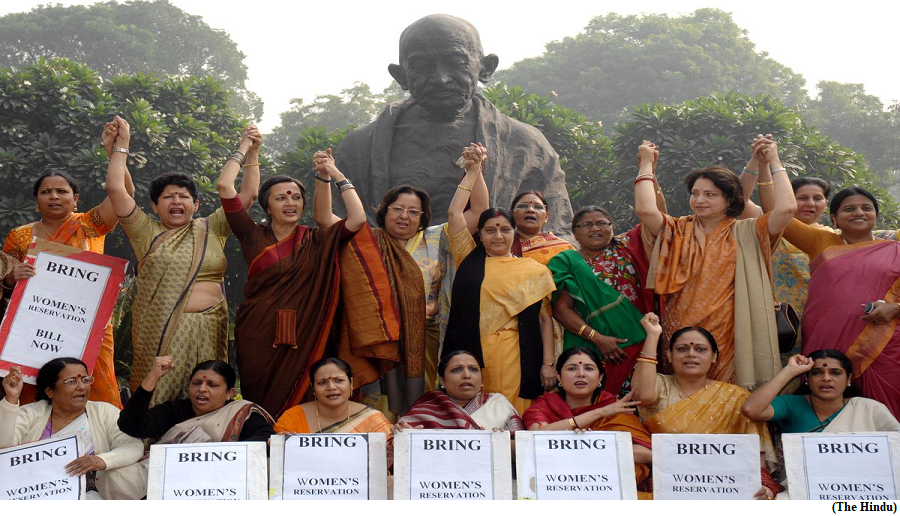The women reservation Bill cannot wait any longer (GS Paper 1, Social Issues)

Context:
- Even 75 years after Independence, Parliament lacks substantial representation from half the population, with women holding just 14% of the seats.
- Despite all of the promises and claims of ending the gender gap, the Women’s Reservation Bill is one of the Indian Parliament’s longest pending bills.

A regression after a promising start:
- Women played a crucial role in India’s fight for independence, by organising demonstrations, leading rallies, and raising awareness. There were numerous female representatives in the Constituent Assembly as well.
- Just a decade ago, three of India’s largest States, West Bengal, Tamil Nadu, and Uttar Pradesh, were in the spotlight for being led by women Chief Ministers.
- While Sushma Swaraj led the Opposition in the Lok Sabha, Sonia Gandhi served as both President of the Congress Party and Chairperson of the United Progressive Alliance.
- Also, India had its first woman President, Pratibha Patil around the same time.
- Despite the presence of influential women in Indian politics, we have regressed since the 1980s and patriarchal backlash has resulted in the status of women in India being far from ideal.
- Hence it will not be wrong to infer that the issue of political representation of women is a greater case, as opposed to having token representation.
Struggle for women’s reservation in India:
- The discourse on women’s reservation in India originates from the pre-Independence era when several women’s organisations demanded political representation for women.
- It can be traced back to 1955 when a government appointed committee recommended that 10% of seats in the Lok Sabha and State legislative assemblies should be reserved for women. However, it was not until the 1980s that the demand for women’s reservations gained momentum.
- The National Perspective Plan for Women (1988) recommended that 30% of seats in all elected bodies should be reserved for women. This recommendation was reiterated in the National Policy for the Empowerment of Women, which was adopted in 2001.
- In 1993, the Panchayati Raj Act was amended to reserve 33% of all seats in local government bodies for women, which was a significant step towards women’s political empowerment.
- The success of this reservation led to demands for similar reservations in other elected bodies.
Introduction of Women’s Reservation Bill:
- The Women’s Reservation Bills were introduced in Parliament in 1996, 1998, 1999, 2008 and 2010 respectively. But it could never pass due to a lack of equality and justice by not providing quotas for OBC and minority women.
Key Highlights of the bill:
- One-third of the seats in the Lok Sabha and the Legislative Assemblies of the States to be filled by direct election shall be reserved for women.
- Under clause (1) of Article 330 and clause (1) of Article 332 of the Constitution, one-third of the seats are reserved for women belonging to scheduled castes and scheduled tribes.
- There is no reservation of seats in the Lok Sabha for women from states with less than three seats.
- If the number of seats reserved for SC or ST in a state is less than three, then there is no reservation for women belonging to SC or ST.
- Seats will be set aside for women on a rotation basis.
- There is no reservation of seats for OBC women and minority women.
- There is no reservation of seats for women in the Rajya Sabha or state legislative councils.
Global examples:
- Around the world, women leaders are outperforming their male counterparts.
- The Scandinavian countries have implemented policies and governance structures that support gender equality and women’s empowerment, which includes women’s representation in political and leadership positions.
- Moreover, countries led by women have shown to have some of the best policies and governance practices. The deep scars in Rwanda, a central African nation, from the genocide, are being healed by predominantly a leadership that comprises women; this has also resulted in key social reforms.
- Norway implemented a quota system in 2003 that required 40% of seats on corporate boards to be occupied by women. Now, it is time for the women in India, the ‘mother of democracy’, to lead the nation.
Call for equality:
- Babasaheb Ambedkar was of the opinion that the progress of a community can be measured by the degree of progress which women have achieved, but we are still far away from that benchmark.
- Equality cannot wait any longer and the time for change is now. Women have been waiting for too long for their right to govern not just for themselves but for the greater common good.
- Women’s leadership qualities are not hidden from anyone, so the denial of opportunity for political representation represents grave injustice.
Way Forward:
- A nation that still struggles to provide basic health care and education, necessary for the dignified life of citizens, must now let women take charge of the task of transforming India.
- As India strives to become a Vishwa Guru, we must not overlook the pivotal role women can play in nation building and development. The women’s reservation Bill cannot wait any longer. The Bill must be passed.



